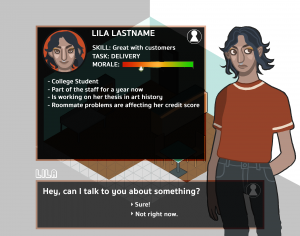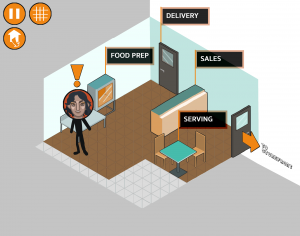 Introduction
Introduction
This week, our team continued to develop the concept of the game, focusing specifically on the tone we wanted the game to have and balancing entertainment and education. We ran our initial concepts through with some playtesters to make sure we were on the right track and started programming the progression of the day. We also continued developing the art assets for the store and starting drafting an outdoor map for where the financial institutions would be.
Playtesting
While we didn’t have access to many people in our target demographic, the team wanted to test the ideas that we developed for the game on a group of people to make sure that we are on the right track. Therefore, we created some paper mockups of how the game would run, with employee interaction and the basic store screen to show to some freshmen at CMU, who were the closest people we could get to the target demographic. We sat down with each playtester for 10-15 minutes and ran them through the game, explaining how the different mechanics would work in the final product. We also gave an example of what kind of employee interactions there could be using the employee Lila, who we designed. After we walked the playtesters through the experience, we asked for verbal feedback and administered a post-experience survey that they had to fill out, essentially asking how clear the game was in meeting its financial literacy goals.

Sitting with freshmen playtesters on Tuesday
The feedback received from the paper playtesting was positive, for the most part. Most of the playtesters said that they understood how the game was going to run and thought that the game would be enjoyable. One of the biggest problems we had last week was finding out if we wanted to make the game more realistic or fantastical. The paper prototype we showed took a more realistic approach, which seemed to be received well, although two playtesters said that they’d prefer something more high fantasy. However, in general, there doesn’t seem to be a large problem with the approach we are taking. Additionally, the team was concerned that the game would not be fun, especially given the topics that it is trying to teach. Playtesters told us that the idea of including minigames to make the game more engaging and using storylines to present the financial problems was a good way to make the game interesting, but not boring. Some playtesters also gave feedback about the UI elements and said they weren’t intuitive, since they asked us to explain some of them, so we’ll be changing some of the graphics to make them easier to understand. Overall, the playtesting session gave us a lot of good information.

Game images used for paper playtesting

Game images used for paper playtesting
Programming
Most of this week was spent setting up the project on GitHub and getting the preliminary classes set up in Unity. Earlier in the week, programmers ran into a little trouble getting the GitHub project set up. Therefore, the first few days of the week were dedicated towards trying to get it running on every team member’s machine. Afterwards, programmers spent the rest of the week focused on getting all the classes set up and started programming some of the UI elements of the game. The two main goals of this week was to start running the game through a day iteration of the game and working on money decrementation as well as supply incrementation based on deliveries. Both were started and are expected to be completed by the next week.
Art
For the first few days of this week, artists focused on making the art assets for the playtesting event that we held on Tuesday. They worked on some separate buttons assets and put together screenshots of the game screen. Not much was polished on the store layout, but after showing the store to playtesters, they gave our artists some ideas on what to add. We’ve decided to add a display case that can show stock diminishing, as a way to help players understand that they may need to stock up on ingredients. We also decided to add more appliances to the store, likely with simple animations, to show the store running during the day. Artists also started creating the assets for the delivery menu.

Inside of the store

Art for the menu buttons. From the top right, clockwise as follow: pause, balance sheet, menu
Next Steps
In the coming weeks, we want to continue implementing the main mechanics of the game. While we appreciated the playtesting we were able to do, we have an additionally opportunity to playtest some more with students actually in our target demographic. Therefore, we will be issuing a survey to them to collect more information on what makes a successful financial literacy game. We’ll also continue working on the script and art to bring the narrative aspect of the game to life.